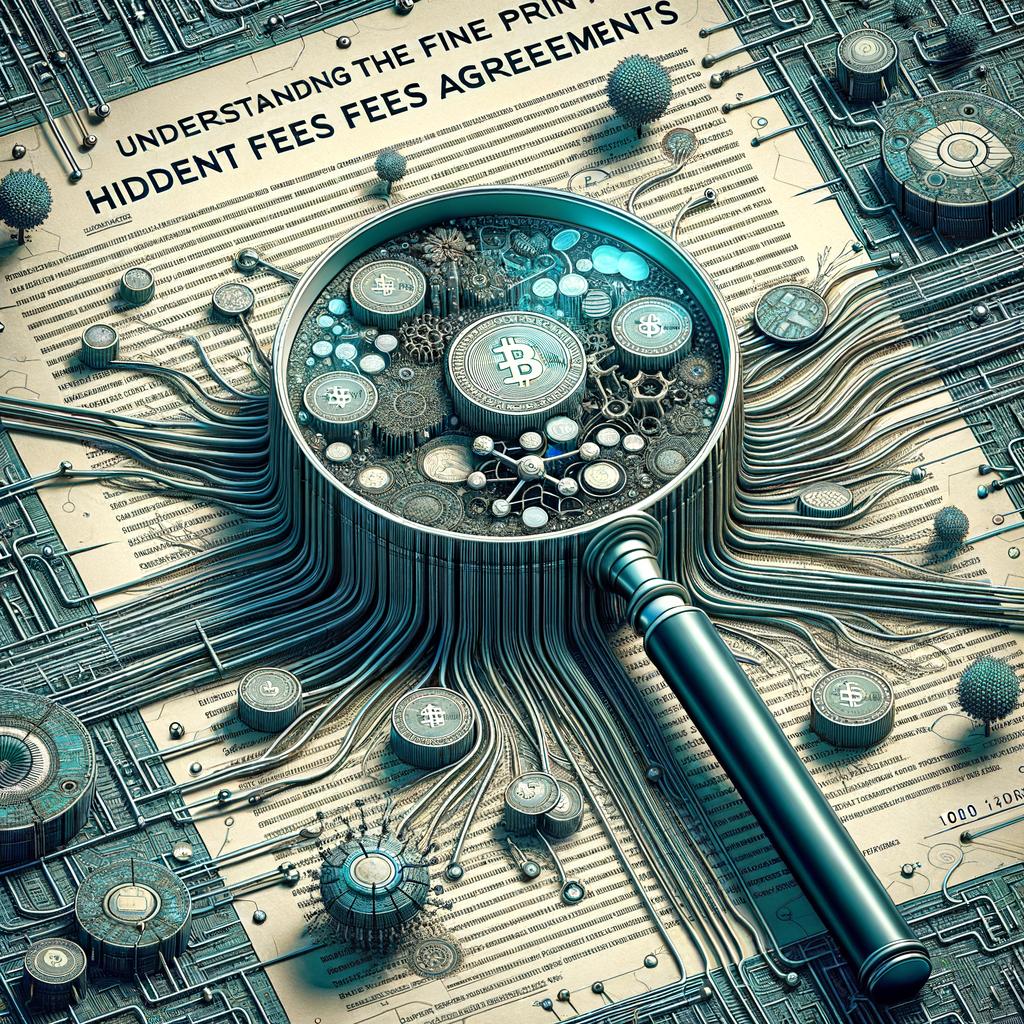Card Payment Processing Fees and Pricing Structures
Card Payment Processing Fees and Pricing Structures: Insights into understanding fee structures, hidden charges, and tips for choosing cost-effective processing solutions.
Let’s face it, nobody likes reading the fine print. It’s like trying to decipher an ancient language filled with jargon and legal mumbo jumbo. But when it comes to payment processing agreements, taking the time to understand the fine print can save you from getting hit with unexpected fees.
Hidden fees are the bane of every business owner’s existence. You sign up for a payment processing service thinking you’re getting a great deal, only to be blindsided by a slew of charges that you didn’t even know existed. That’s why it’s crucial to dig deep into the fine print before signing on the dotted line.
One common hidden fee to watch out for is the PCI compliance fee. This fee is charged by payment processors to cover the costs of ensuring that your business is compliant with the Payment Card Industry Data Security Standard (PCI DSS). While it’s essential to protect your customers’ data, some processors will sneak in hefty fees for this service without clearly disclosing it upfront.
Another sneaky fee to be aware of is the chargeback fee. Chargebacks occur when a customer disputes a transaction, and the processor charges you a fee for handling the dispute. Some processors will tack on additional fees for chargebacks, so make sure you know exactly what you’re getting into before signing any agreements.
And let’s not forget about the dreaded early termination fee. Some processors will try to lock you into a long-term contract and charge you exorbitant fees if you try to cancel before the contract term is up. Make sure to read the fine print carefully to avoid getting stuck in a costly agreement.
So, how can you protect yourself from hidden fees in payment processing agreements? The key is to read the fine print carefully, ask questions if something isn’t clear, and negotiate any fees that seem unreasonable. By taking the time to understand the fine print, you can avoid getting blindsided by hidden fees and keep your hard-earned money where it belongs – in your pocket.
As a startup or small business owner, every penny counts when it comes to running your business. One area where costs can quickly add up is in card processing fees. However, there are ways you can save on these costs and keep more money in your pocket.
One tip for saving on card processing costs is to shop around for the best rates. Different providers offer different fee structures, so it’s important to compare options before making a decision. Look for providers that offer competitive rates and low fees, but be sure to read the fine print to understand any additional charges that may apply.
Another way to save on card processing costs is to negotiate with your current provider. If you’ve been a loyal customer and have a strong payment processing history, your provider may be willing to offer you a better rate. Don’t be afraid to ask for a discount or negotiate for a lower fee – the worst they can say is no.
Additionally, consider investing in technology that can help you save on processing costs. For example, using a mobile card reader can lower fees compared to traditional POS systems. Look for tools that streamline the payment process and offer cost-saving benefits for your business.
Lastly, consider passing on processing fees to your customers. While this may seem counterintuitive, many businesses now charge a small convenience fee for customers who choose to pay with a card. This can help offset the cost of processing fees and ensure that your bottom line isn’t taking a hit.
By being proactive and strategic about how you handle card processing fees, you can save your startup or small business valuable money that can be reinvested into growing your business. Don’t let high processing costs hold you back – take control of your expenses and watch your business thrive.
Do you find yourself scratching your head every time you receive your monthly statement from your credit card processor? Are you wondering why your fees seem to fluctuate even though you’re not changing your sales volume? Well, the answer may lie in the number of transactions you process each month.
It’s a common misconception that processing fees are solely based on the total dollar amount of sales. While that is a significant factor, the volume of transactions also plays a crucial role in determining how much you pay in fees. Let’s break it down.
Imagine you run a small boutique that sells handmade jewelry. On a typical month, you make $10,000 in sales with an average ticket size of $50. Now, let’s say you process these sales with an interchange-plus pricing model, where your processor charges you a flat fee plus a percentage of each transaction.
If you have 200 transactions in a month, each transaction will incur its own processing fee. However, if you have 100 transactions that total $10,000, your processing fees will be significantly lower because you’re paying fewer per-transaction fees.
The more transactions you have, the more fees you’ll pay. This is because every time you swipe a card or key in a transaction, your processor incurs costs to authorize and settle that payment. These costs add up, and processors pass them on to you in the form of transaction fees.
But fear not! There are ways to mitigate the impact of transaction volume on your processing fees. For starters, try to bundle transactions together whenever possible. Instead of processing multiple small transactions, consider combining them into larger transactions to reduce the number of per-transaction fees you pay.
Additionally, you can negotiate with your processor to see if you can get a better deal based on your transaction volume. Some processors offer volume discounts for businesses that process a high volume of transactions each month.
In conclusion, transaction volume can have a significant impact on your card processing fees. By understanding how this works and taking strategic steps to manage your transaction volume, you can save money and streamline your payment processing. So next time you review your statement, you’ll have a better grasp of why your fees are what they are.
So, you’ve finally decided to take the plunge and start accepting credit card payments at your small business. Congratulations! However, as you start shopping around for credit card terminals, you quickly realize that there are two options available: leasing or buying.
Leasing a credit card terminal may seem like a convenient option at first. You get the latest technology without a large upfront investment, plus you can easily upgrade when new models become available. However, it’s important to remember that leasing comes with its fair share of fees. Monthly rental fees, maintenance fees, and other hidden charges can quickly add up over time, costing you more in the long run.
On the other hand, buying a credit card terminal may require a higher initial investment, but it can save you money in the long term. By purchasing a terminal outright, you avoid monthly rental fees and lease agreements. Plus, you have the freedom to shop around for the best deal and negotiate with suppliers for a lower price.
Ultimately, the decision to lease or buy a credit card terminal depends on your individual needs and budget. If you’re a small business owner with limited funds, leasing may be the more practical choice. However, if you’re looking to save money in the long run and have the financial means to do so, buying a terminal may be the smarter option.
As you weigh the pros and cons of leasing versus buying a credit card terminal, be sure to factor in other considerations such as customer service, technical support, and warranty coverage. After all, you want a reliable terminal that will help streamline your payment process and keep your customers coming back.
Whether you decide to lease or buy, remember that credit card terminal fees are just a small part of running a successful business. With the right terminal and payment processing system in place, you can focus on what really matters – delivering top-notch products and services to your customers. Cheers to smooth transactions and happy customers!
Are you tired of feeling like you’re being ripped off every time you look at your credit card processing fees? It may be time to consider making a switch. Switching your card processor could potentially save you big bucks in the long run. But is the cost analysis worth it? Let’s break it down.
Why should you even consider switching your card processor? Well, for starters, the fees associated with credit card processing can eat away at your profits faster than you can say “swipe.” By finding a processor that offers lower rates and better benefits, you could significantly increase your bottom line.
But before you jump ship, it’s important to do a thorough cost analysis. Take a look at your current processing fees, including interchange rates, processing fees, and any other additional charges. Then compare these costs to what other processors are offering. Don’t forget to factor in any potential savings, benefits, or improved services that a new processor may offer.
Switching your card processor may come with a price tag. You may have to pay cancellation fees, equipment costs, or other transition expenses. However, if the potential savings outweigh these initial costs, it may be worth it in the long run.
In addition to potential cost savings, switching your card processor could also lead to improved customer service, better technology, or other benefits that can enhance your business operations. By taking the time to conduct a thorough cost analysis, you can determine whether making the switch is worth it for your business.
So, is switching your card processor worth it? The answer will vary depending on your specific circumstances. But one thing is for sure – by taking the time to analyze the costs and benefits, you can make an informed decision that will ultimately benefit your business. So go ahead, crunch those numbers, and see if making a switch will pay off in the long run.
Merchant services billing can often feel like trying to decipher a cryptic code. With all the different fees and charges that come along with accepting credit card payments, it’s no wonder why some business owners feel overwhelmed when it comes time to review their monthly statement. One particular area that can cause confusion is statement fees.
Statement fees in merchant services billing are essentially the cost associated with processing and sending out your monthly statement. While this fee might seem insignificant compared to some of the other charges on your bill, it’s important to understand exactly what you’re being charged for.
Breaking down statement fees can help demystify the billing process and empower business owners to take control of their financials. Here’s a closer look at what statement fees entail:
1. Monthly Fee: This is a fixed charge that covers the cost of generating and sending out your statement each month. It helps to offset the administrative costs associated with processing your account.
2. Processing Fee: In addition to the basic monthly fee, some merchant services providers might also include a processing fee for each transaction that is included on your statement. This fee helps cover the cost of processing and reconciling each transaction.
3. Additional Charges: Depending on your provider, there may be additional charges included in your statement fee. These could range from account maintenance fees to online reporting fees. It’s important to review your statement carefully to ensure you understand what you’re being charged for.
Understanding statement fees in merchant services billing can help you better manage your finances and make more informed decisions about your payment processing. By breaking down these fees, you can take control of your billing and ensure that you’re getting the best value for your money. So the next time you receive your monthly statement, don’t let those fees intimidate you – instead, embrace the opportunity to gain a deeper understanding of your financials and take charge of your business’s future.
Card processing fees can often seem like a maze of hidden charges, creeping up on your business when you least expect it. These sneaky fees can eat away at your profits, leaving you wondering where all your hard-earned money has gone. But fear not, there are ways to identify and avoid these hidden charges before they catch you off guard.
One of the first steps in recognizing hidden charges is to read the fine print. Many card processing companies will bury fees in the terms and conditions, hoping that you won’t notice. Take the time to carefully review all the details of your agreement so that you know exactly what you’re signing up for. If something seems too good to be true, it probably is.
Another way to spot hidden charges is to look out for overage fees or additional transaction fees. Some processors will charge you extra if you exceed a certain number of transactions per month or if your average ticket size falls below a certain threshold. These fees can quickly add up, so make sure you understand your processor’s pricing structure.
Additionally, keep an eye out for interchange fees. These are the fees that banks charge to process credit card transactions, and they can vary depending on the type of card used and the size of the transaction. While you may not be able to avoid interchange fees entirely, you can shop around for a processor that offers competitive rates.
Finally, be wary of equipment and software fees. Some processors will try to sell you expensive hardware or software that you don’t really need, and they’ll tack on additional fees for maintenance and support. Before you invest in any new equipment, do your research and make sure you’re getting the best deal possible.
By staying vigilant and educating yourself about the potential pitfalls of card processing fees, you can avoid getting caught in the trap of hidden charges. Remember, knowledge is power, so arm yourself with the information you need to protect your business and your bottom line.
If you’re a small business owner, chances are you’ve heard of interchange fees but may not fully understand what they entail. Don’t worry, you’re not alone! Interchange fees are the fees paid by merchants to card networks like Visa and Mastercard for processing credit and debit card transactions. Essentially, these fees are the cost of convenience for accepting card payments from customers.
So, why should you care about interchange fees? Well, for starters, they can eat into your profit margins. Every time a customer swipes their card at your store, you’re charged a small fee by the card network. These fees can quickly add up, especially for businesses processing a high volume of card transactions.
But fear not, there are ways to mitigate the impact of interchange fees on your bottom line. For one, you can negotiate with your payment processor for lower fees. Many processors are willing to work with small businesses to find a pricing structure that works for both parties. Additionally, you can encourage customers to pay with cash or debit cards, as these transactions typically have lower interchange fees than credit card transactions.
In the end, understanding interchange fees is key to managing your business expenses effectively. By knowing what you’re paying and why, you can make informed decisions about how to best accept card payments at your business. So, next time you see that little “swipe fee” on your statement, you’ll know exactly what it means and how to make it work in your favor.
Are you running an e-commerce site and wondering why your profits seem to be going down the drain? Well, have you considered the impact of those sneaky payment gateway fees on your bottom line? Let’s face it – payment gateway fees may seem like a necessary evil in the world of online transactions, but they can actually have a significant impact on your overall revenue.
Imagine this – for every purchase made on your site, a small percentage is deducted as a payment gateway fee. Doesn’t sound like much, right? Wrong. Those small percentages can add up quickly, especially if you have a high volume of sales. Suddenly, you find yourself losing a chunk of your hard-earned money to these pesky fees.
But wait, it gets worse. Not only do payment gateway fees eat into your profits, but they can also deter potential customers from completing their purchases. Think about it – if a customer sees an additional fee tacked on at checkout, they may rethink their decision to buy from your site. After all, no one likes hidden costs, right?
So, what can you do to combat the impact of payment gateway fees on your e-commerce site? Well, for starters, you can shop around for the best payment gateway provider that offers competitive rates. Do your research and compare fees from different providers to find the one that aligns best with your business goals.
Additionally, you can implement strategies to offset these fees, such as adjusting your pricing strategy or offering discounts for customers who opt for certain payment methods. By getting creative and finding ways to minimize the impact of payment gateway fees, you can ensure that your e-commerce site remains profitable and competitive in the long run.
In conclusion, payment gateway fees may seem like a minor detail in the grand scheme of running an e-commerce site, but they can have a major impact on your financial health. By taking proactive steps to minimize these fees and maximize your profits, you can ensure that your online business thrives in the ever-evolving world of e-commerce.
As a business owner, you may have heard the term “PCI compliance fees” thrown around in conversations about payment processing. But what exactly are these fees, and why should you care about them?
In a nutshell, PCI compliance fees are charges imposed by payment processors to ensure that your business is in compliance with the Payment Card Industry Data Security Standard (PCI DSS). This standard was established to protect sensitive cardholder data and reduce the risk of data breaches for businesses that process credit card payments.
While it may sound like just another fee to add to the list of expenses for your business, PCI compliance fees are actually quite important for a few key reasons. First and foremost, maintaining PCI compliance helps to protect your customers’ sensitive data, which is essential for building trust and loyalty with your clientele. In today’s world where data breaches are becoming increasingly common, safeguarding your customers’ information should be a top priority.
Secondly, failure to comply with PCI DSS can result in hefty fines and penalties from credit card companies and regulatory bodies. These fines can quickly add up and potentially drive your business into financial ruin if not addressed promptly. By paying the necessary PCI compliance fees and implementing the required security measures, you can avoid these costly consequences and protect your bottom line.
Lastly, being PCI compliant can also improve your business’s reputation and credibility in the eyes of both customers and partners. Demonstrating that you take data security seriously and are committed to protecting customer information can help you stand out in a crowded market and attract more business opportunities.
In conclusion, PCI compliance fees may seem like just another expense, but they are an essential investment in the security and success of your business. By understanding what these fees are and why they matter, you can make informed decisions to protect your customers, your business, and your reputation in the long run.










